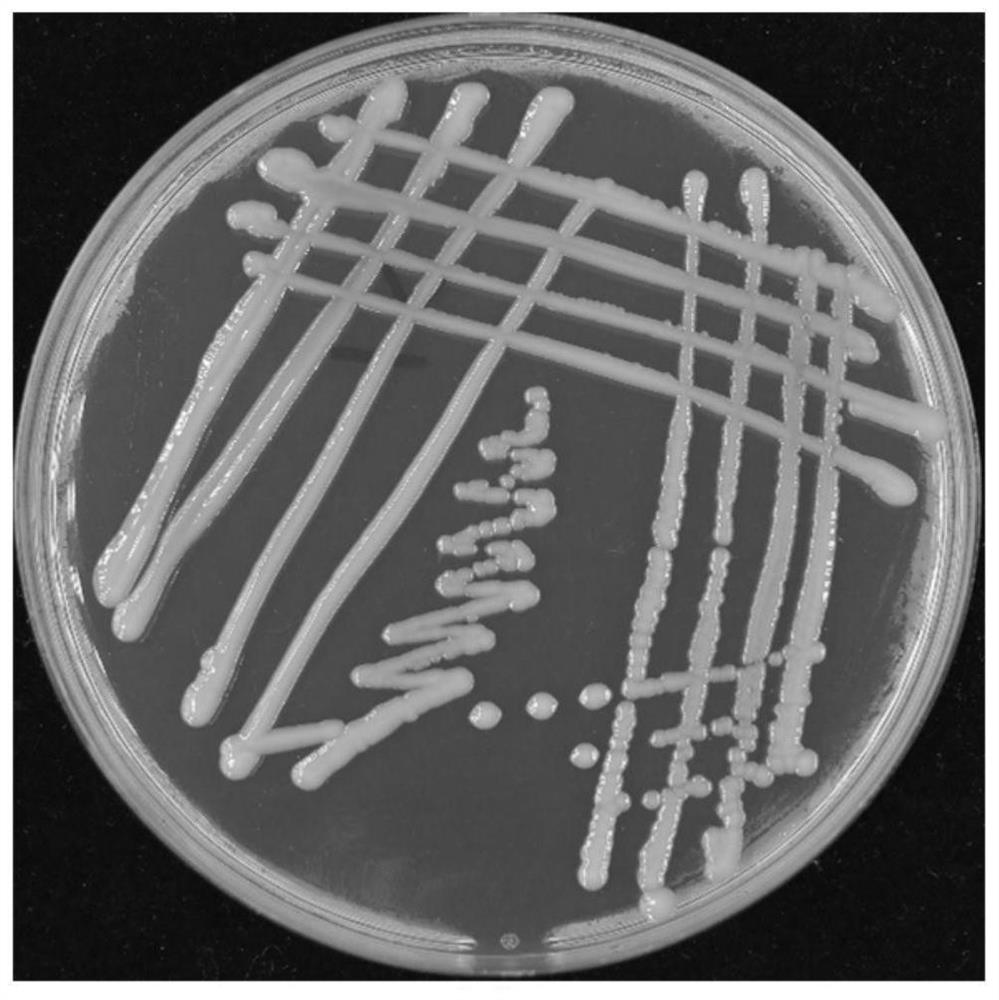Klebsiella aerogenes and application thereof
A technology of Klebsiella and strains, applied in the field of Klebsiella aerogenes, can solve problems such as ecological environment pollution and human health threats
- Summary
- Abstract
- Description
- Claims
- Application Information
AI Technical Summary
Problems solved by technology
Method used
Image
Examples
Embodiment 1
[0053] Screening, isolation, purification and identification of Example 1 bacterial strain S1
[0054] 1. Screening method for a strain S1 resistant to cadmium and removing cadmium ions
[0055] 1. Material preparation
[0056] Soil source for strain screening: Taken from the polluted soil of the paddy fields around Dabaoshan, Shaoguan City, Guangdong Province, the soil samples were sealed with sampling bags, and brought back to the laboratory at 4°C for storage for later use.
[0057] LB medium: peptone 10.0g, yeast extract powder 5.0g, NaCl 10.0g, pH 7.0-7.2, distilled water to 1L; solid medium plus 18.0g agar powder. Sterilize at 121°C for 15 minutes.
[0058] Inorganic salt medium (MSM medium): 5mL phosphate buffer solution (KH 2 PO 4 8.5g·L -1 、K 2 HPO 4 ·H 2 O2 1.75g·L -1 、Na 2 HPO 4 12H 2 O 33.4g·L -1 , NH 4 Cl 5.0g L -1 ), 3.0mL22.5g·L -1 MgSO 4 Solution (MgSO 4 ·7H 2 O 46.125g·L -1 ), 1.0mL 0.25g·L -1 FeCl 3 Solution (FeCl 3 ·6H 2 O 0.42g·L -...
Embodiment 2
[0081] Example 2 strain S1 containing Cd 2+ Cd in inorganic salt medium with peptone 2+ removal of
[0082] Streak the strain S1 on the LB plate, culture at 30°C for 20h, pick a single colony and inoculate it in the LB liquid medium, 30°C, 150r min -1 After culturing in the shaker for 20 hours, they were inoculated to Cd at a ratio of 2% (v / v) 2+ Concentrations of 10, 20, 40 and 80 mg·L -1 containing 10g·L -1 Tryptone was cultured in MSM medium, and samples were taken after 6 d (days); no addition of strain S1 was used as the control (CK), and three repeated experiments were set up. Sample liquid at 80000r·min -1 After centrifugation for 10 min, the supernatant was filtered with a 0.22 μm membrane filter, and its Cd was determined by flame atomic absorption spectrometry (AAS) after filtration. 2+ Residual amount (method is with embodiment 1).
[0083] Cd after 6 days of culture 2+ removal efficiency as image 3 Shown: The results show that after addition of strain S1,...
Embodiment 3
[0084] Phosphorus-dissolving and potassium-dissolving qualitative test of embodiment 3 bacterial strain S1
[0085] Solubilizing phosphorus and potassium of strain S1 (phosphate solubilizing bacteria, meaning converting insoluble phosphorus and potassium into soluble phosphorus and potassium) (specific references: Rawat, P., Das ,S.,Shankhdhar,D.,et al.,Phosphate-solubilizing microorganisms: Mechanism and their role in phosphate solubilization and uptake[J].Journal of Soil Science and Plant Nutrition.2020,https: / / doi.org / 10.1007 / s42729 -020-00342-7.) Functional qualitative test: Inoculate the strain S1 drawn on the LB solid medium into the LB liquid medium, shake and culture at 125~150rpm, 28~30°C for 18~24h, and then spot Connect on PKO solid medium and potassium bacteria solid medium, and inoculate 2% on PKO liquid medium and potassium bacteria liquid medium, establish 3 repeated experiments, place 30 ℃ incubator or shaker (125~150rpm ) 6d, observe the transparent circle fo...
PUM
 Login to View More
Login to View More Abstract
Description
Claims
Application Information
 Login to View More
Login to View More - R&D
- Intellectual Property
- Life Sciences
- Materials
- Tech Scout
- Unparalleled Data Quality
- Higher Quality Content
- 60% Fewer Hallucinations
Browse by: Latest US Patents, China's latest patents, Technical Efficacy Thesaurus, Application Domain, Technology Topic, Popular Technical Reports.
© 2025 PatSnap. All rights reserved.Legal|Privacy policy|Modern Slavery Act Transparency Statement|Sitemap|About US| Contact US: help@patsnap.com



